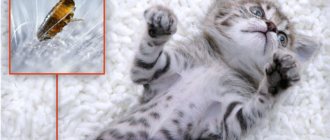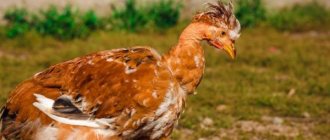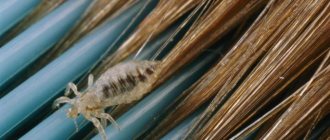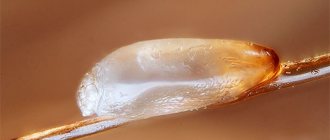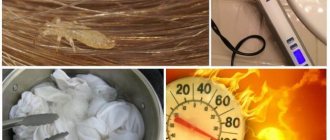What kind of disease is pediculosis, and who are lice?
Pediculosis is a disease where lice appear on the human body. Of course, not every variety of these insects can take root on the human body.
The human louse is an insect from the order of parasites. There are two known varieties that occur in humans - cephalic and pubic. The first lives in the hair on the head, and the second in the hair of the pubic area of the body. Both are quite difficult to get rid of, although they do not penetrate the body.
Pediculosis is diagnosed when there are a lot of these parasites on the body. It is difficult to fight parasites, since they multiply very actively. For example, an adult female is capable of laying on average 6 eggs (nits) per day. Very quickly, the egg hatches into a larva, which becomes an adult after 10 days.
The difficulty of breeding also lies in the fact that these insects are microscopic in size. It is quite difficult to notice their appearance in the hair, so by the time their presence becomes obvious, they manage to multiply to huge numbers.
Head louse - what is it?
To detect a parasite, you need to understand what head lice are, what they look like, and how they move. For example, it is known that these insects cannot jump or fly, but only crawl from hair to hair or from head to head.
Head lice are tiny insects that infest the human body. They are gray in color, but, as a rule, change their shade, masquerading as the color of human hair.
The female has a long, flattened body measuring about 2-4 mm. Males are slightly smaller in size than females. Parasites have three pairs of legs, at the ends of which there are peculiar hooks with which they are attached to the shaft of the hair. These parasites are very mobile: in a minute, an adult insect can cover a distance of 25 centimeters. In addition, head lice are prolific enough to increase their population significantly in a short time.
Adults lay eggs called nits, which are firmly attached to the root of the hair. After about a week and a half, nymphs hatch from them - this is what the young offspring of lice are called. The development of a head louse from the nymph stage to the adult lasts approximately 10-12 days. After this, the female is ready to reproduce. Insects feed on human blood. By biting the scalp, they cause itching, irritation, and burning of the scalp.
How to understand that you have lice: The main symptoms of lice
Experts say that the first symptoms and signs of lice infestation appear in a person only after a few weeks. This is due to the reasons stated above. Sources of infection include:
- • close contact with a person who already has lice;
- • wearing the same headdress with an infected person;
- • sharing the same pillowcase with the infected person.
Most often, lice is detected in children and those who use the services of dubious or cheap hotels.
The main symptoms of this disease include:
- • The appearance of gray-brown or white spots on the hair. The gray-brown ones are lice, and the white ones are their eggs or, as they are also called, nits.
- • The appearance of red spots on the skin of the head are traces of lice bites. They feed on blood in the scalp and nutrients from the epithelium.
- • Itching, as a symptom of the presence of the parasite, occurs extremely rarely - in approximately 15-25% of cases of infection.
- • Allergic reactions on the skin can also be one of the signs of lice. While feeding on human blood, this insect pierces the skin and injects saliva into it. Some people may be allergic to it
- • Abundant appearance of “dandruff”, which many people mistake for lice larvae (nits). This kind of dandruff is almost impossible to shake off. The eggs are very firmly attached with an adhesive to the very base of the hair root on the surface of the skin.
The symptoms are not very obvious as there can be many other explanations. Checking for lice is quite simple. You can take a magnifying glass and ask family members to take a close look at what's going on in the hair.
What diseases are transmitted by lice?
Lice feed on human blood. During a bite, insect saliva enters the body, which causes inflammatory and allergic processes and severe itching. Dangerous infectious agents can penetrate through skin lesions.
Lice are carriers of the following diseases:
- • typhus;
- • relapsing fever;
- • Volyn fever.
Typhus is caused by the bacterium Rickettsia. Upon contact with a sick person, the louse transfers the pathogen to healthy people. The disease is accompanied by weakness, pain in the muscles and head, fever, and damage to the mucous membranes of the eyes. After some time, internal hemorrhages occur, and a rash appears on the body.
Relapsing fever is accompanied by fever, weakness, and intoxication syndrome. The skin of a sick person turns yellow, and diarrhea may occur. Periods of poor health are followed by temporary improvement. The disease can result in internal bleeding, pneumonia, and myocarditis. Many of these complications are fatal to humans.
Volyn fever is milder than typhus. Intoxication syndrome is pronounced. The symptoms are similar to the clinical manifestations of typhus. The illness lasts several weeks and usually does not require hospitalization. In people with weakened immune systems, it causes serious infections and disturbances in the functioning of internal organs.
The most common complications of pediculosis found in modern people include pyoderma. These diseases cause purulent-inflammatory changes in the skin due to the addition of a secondary infection. But such consequences can be easily avoided if treatment is started on time. Then the spread of human head louse diseases will not threaten your health.
How to tell if you have lice
What to do if there is no way to turn to someone for help in this matter? There are several ways to tell if you have lice.
Many people wonder how to see lice, because they have a small body (from 3 to 5 mm), which is distinguished by inconspicuous colors. Individuals can be either gray or light brown in color. It is very difficult to detect them visually, both in light and dark hair, until the number of individuals increases several times. So how do you know if you have lice? You can find out about this by a number of signs, which include:
- • frequent desire to scratch your head (which will only intensify over time);
- • indication from loved ones that small red spots (bite marks) have appeared in the area of the ears or on the scalp;
- • you can recognize whether there are lice by the frequent sensation that the hair is moving on its own;
- • You can accurately determine the appearance of a parasite by a large amount of dandruff, which cannot be combed out with a comb or treated with special means.
All this taken together may indicate the appearance of a human louse. If you have such doubts, it is best to consult a doctor and get examined.
How to detect nits
Adults cannot always be seen without aids. They cling tenaciously to the hair and can be immobile. These insects are brown or gray-brown in color and darken when saturated with blood. So sometimes they are indistinguishable against the background of hair.
If you have lice on your head, there will definitely be nits - parasite eggs. They are attached at the base of the hair, and only one nit can be attached to one hair. But females lay eggs in a crowded pattern - on adjacent hairs. Therefore, when heavily infested, they are arranged in clusters. Nits are often confused with dandruff. They are as small and white as flaking scales on the scalp. But the difference is that dandruff is located directly on the skin, and nits are located on the hair.
When examining your head to determine whether you have lice and nits, you need to pay attention to the hair at the back of the head and temples. This is where a large number of nits are usually found. They sit tightly on a hair, as the female secretes a special secretion that glues them. When trying to remove nits, you have to make an effort. When treating head lice with folk remedies, a vinegar rinse is used, which corrodes this adhesive composition. While dandruff can be brushed off your head with your hand, this cannot be done with nits.
What to do if lice are found
If doubts about lice infection are confirmed, a number of mandatory measures must be taken:
- • Washing all bedding at elevated temperatures
- • Isolation from public places, and better yet from family members. These parasites are transmitted through close contact between people. During treatment, you need to exclude all communication with other people or, at a minimum, reduce it as much as possible.
- • Immediate treatment.
Modern methods of treating this disease make it possible not to visit a doctor. If you are absolutely sure that you have lice, it is enough to purchase a specialized drug at the pharmacy (it is available without a prescription) and begin to follow the instructions.
The main means of treating pediculosis
Among the drugs intended for the treatment of pediculosis are the following:
- • Mechanical method. This method is effective only as a complement to the use of special means. Lice and nits must be combed out with a special fine-toothed comb. To do this, it is necessary to separate individual strands from the total mass of hair and comb them thoroughly. It is advisable to do this over a dark cloth or paper so that the combed out larvae are visible.
- • Traditional methods. Previously, traditional medicine methods that were dangerous to humans were used to treat pediculosis - kerosene, dust treatment, and so on. You should not use such aggressive methods. There are safer ways, for example, cranberry juice with honey. Both ingredients are mixed in equal proportions and applied to the hair and scalp. After half an hour, lice and nits are thoroughly combed out.
- • Proven pharmaceutical products. The main thing that is needed to remove these parasites is an anti-pediculosis agent.
Tips and tricks
Any pharmacy offers a large selection of modern products for the treatment of head lice. Modern formulations are applied directly to the hair on which the parasites have settled. And it can be not only the head. Lice can even live on eyebrows and eyelashes.
Such products contain chemicals that are toxic to lice. For this reason, preparations for getting rid of lice should be used with caution by pregnant women, nursing mothers, young children, as well as people with sensitive skin and allergies.
Before use, it is better to test on the skin of the wrist. To do this, apply a small amount of the product and wait at least 2 hours. If redness or other specific reaction occurs, you should choose another treatment method. When using insecticidal shampoos, creams or sprays, it is recommended to use disposable gloves.
Lice larvae, called nits, can successfully survive exposure to toxic chemicals due to their tough shell. Only adult individuals can be destroyed by medication. For complete cure, it is recommended to combine the use of chemicals with a mechanical method of getting rid of lice.
No matter how powerful the medicinal composition is, the mechanical method plays a very important role - the final combing out of the nits with a special comb. This will remove any remaining eggs. The main method of combating lice at all times was combing. It consists of mechanically manually removing lice and nits from hair using a comb or a special comb, which can be purchased at a pharmacy. To do this, you first need to rinse your hair well with regular shampoo. Then dry it, loosen the long hair and thoroughly comb it with a comb several times until the parasites are completely visually removed. The towel you use to dry your hair must be boiled or washed at maximum temperature, and after drying, iron it.
Unfortunately, it is not possible to get rid of lice in one such procedure. Parasites need to be combed out daily until they disappear completely. In rare cases, this takes a whole month. Special safety precautions must be taken by people who comb out lice from the hair of an infected person. Due to the rapid spread of parasites, it is imperative to protect yourself
- • hide your hair under a scarf, hat or cloth;
- • keep your distance, do not lean too close to your head;
- • combing should be done with gloves.
Perhaps some people think that lice are not such a serious problem, and the biggest nuisance from them is severe itching. However, this is a fundamentally wrong opinion. You need to start fighting lice immediately, immediately after they are identified. After all, they can be carriers of such a terrible disease as typhus, and any infection can get into open wounds from scratching.
Preventive measures
Even if a person has been cured of head lice once, this will not save him from the risk of re-infection. Preventive measures that can help with this include:
- • regular examination of the head of yourself and family members; after all, finding a parasite means already beginning an effective fight against it;
- • distance in public transport or crowded places of strangers;
- • regular washing of bed linen at high temperatures;
- • the use of essential oils that have a repellent effect on parasites: tea tree, lemon balm, thyme and rosemary;
- • wearing hairstyles with collected hair;
How dangerous are lice for children?
Pediculosis is more common in childhood, especially in preschool and school groups. But not all parents know how dangerous lice are for children and how important it is to conduct regular examinations of the scalp, especially for girls with long hair.
Pediculosis causes inflammatory and allergic reactions. Constant itching deprives the child of rest and proper sleep. The imperfection of children's immunity can cause violent reactions of the body in response to the penetration of saliva with foreign lice proteins.
Against the background of pediculosis in children, the cervical and behind-the-ear lymph nodes become enlarged. A chronic rash appears on the skin. Constant scratching causes pustular complications.
Means for effective treatment
One of the most effective assistants in the treatment of head lice is now “Paranitis”. It belongs to the category of products that contain compounds of a low hazard class. The peculiarity of this product is that it contains two active substances: dimethicone and mineral oil. These components affect the respiratory organs of lice and nits, clogging them with their structure. Without the ability to breathe, parasites, their larvae and eggs die very quickly. However, they do not pose any actual danger to human health even when applied to the scalp.
Dimethicone clogs the respiratory tract of parasites, and the oil ensures its easy, uniform application. This way it is possible to achieve maximum efficiency from using this product. The Paranit product line includes different types of products - from shampoos to lotions. Their choice depends on who is more comfortable using what. “Paranit” products can be used from 3 years of age, and the special “Paranit Sensitive” lotion can be used in children from 1 year of age and pregnant women.
